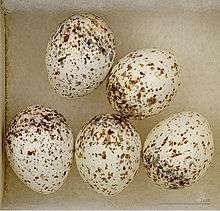Subalpine warbler
The subalpine warbler (Sylvia cantillans) is a small typical warbler which breeds in the southernmost areas of Europe and north-western Africa. It was first described by the German naturalist Peter Simon Pallas in 1764 and given the binomial name Motacilla cantillans.[2][3][4] The current genus name is from Modern Latin silvia, a woodland sprite, related to silva, a wood. The specific cantillans is Latin for "warbling" from canere, "to sing".[5] This small passerine bird is migratory, and winters along the southern edge of the Sahara. It occurs as a vagrant well away from the breeding range, in both spring and autumn as far north as Great Britain.
| Subalpine warbler | |
|---|---|
 | |
| Scientific classification | |
| Kingdom: | Animalia |
| Phylum: | Chordata |
| Class: | Aves |
| Order: | Passeriformes |
| Family: | Sylviidae |
| Genus: | Sylvia |
| Species: | S. cantillans |
| Binomial name | |
| Sylvia cantillans (Pallas, 1764) | |
.jpg)

Like most Sylvia species, it has distinct male and female plumages. The adult male has a grey back and head, brick-red underparts, and white malar streaks ("moustaches"). The female is mainly brown above, with a greyer head, and whitish below with a pink flush. The subalpine warbler's song is fast and rattling, and is similar to the lesser whitethroat.
This bird seems to be related to the Sardinian warbler-Menetries' warbler superspecies. They all have white malar areas, the heads being dark above in adult males, and naked eye-rings. These three species are related to a superspecies consisting of Rüppell's warbler and the Cyprus warbler, which also share the white malar area with blackish above.(Shirihai et al. 2001,[6] Jønsson & Fjeldså 2006 [7]) The subalpine warbler is divided into two distinct subspecies groups, which may possibly be sufficiently diverged to qualify as two separate species (Shirihai et al. 2001).[6] The two groups have differing male plumages, distinctive calls, and are allopatric; further study is needed. In May 2020, the IOC world bird list the split of western and eastern subalpine warbler as two distinct species.[8]
Moltoni's warbler was formerly considered conspecific.
These groups are as follows (areas given below are breeding ranges; all forms winter in Africa):
- Western subalpine warbler – subspecies cantillans, found in north-west and peninsular Italy, Sicily, southern France and Iberia, and inornata found in north-west Africa
- Eastern subalpine warbler – subspecies albistriata, found from north-east Italy southeastwards to southern Turkey
Eastern subalpine warbler differs from the nominate race by its deeper blue-grey upperparts, a blackish mask on the lores and ear-coverts, brick reddish-brown coloration confined to the throat and breast and sharply demarcated from a largely white belly, paler flanks and a wider white submoustachial stripe.[9]
This is a bird of dry open country, often on hill slopes, with bushes for nesting. The nest is built in low shrub or gorse, and 3–5 eggs are laid. Like most "warblers", it is insectivorous, but will also take berries.
Habitat and ecology
This species prefers tall and dense heterogeneous maquis with sparse tree cover in dry Mediterranean areas, particularly maquis of holm oak (Quercus ilex) and those dominated by strawberry tree (Arbutus) and tree-heath (Erica). It is also frequently found in young cork oak (Quercus suber) forest and in dense but treeless bushy areas. It uses bushy formations dominated by brambles (Rubus fruticosus) along sunny ravines and valley bottoms and prefers the intermediate stages of post-wildfire succession. Breeding occurs from late March to late June and the species is monogamous. The male constructs several ‘cock nests’ but both sexes build the breeding nest which is a deep, robust cup of grasses, thin roots and leaves and lined with finer grasses, rootlets and hair. It is placed in low scrub, bush or a small tree, c. 30–130 cm above the ground. Clutches are three to five eggs. The diet is mostly small insects and their larvae but outside of the breeding season berries and fruits are also taken. The species is a long distance migrant, wintering in sub-Saharan Africa (Aymí et al. 2015). [10]
References
- BirdLife International (2012). "Sylvia cantillans". IUCN Red List of Threatened Species. 2012. Retrieved 26 November 2013.CS1 maint: ref=harv (link)
- Mayr, Ernst; Cottrell, G. William, eds. (1986). Check-list of Birds of the World. Volume 11. Cambridge, Massachusetts: Museum of Comparative Zoology. p. 283.
- Sherborn, C. Davies (1905). "The new species of birds in Vroeg's catalogue, 1764". Smithsonian Miscellaneous Collections. 47: 332–341 [337 No. 177]. Includes a transcript of the 1764 text.
- Rookmaaker, L.C.; Pieters, F.F.J.M. (2000). "Birds in the sales catalogue of Adriaan Vroeg (1764) described by Pallas and Vosmaer". Contributions to Zoology. 69 (4): 271–277.
- Jobling, James A (2010). The Helm Dictionary of Scientific Bird Names. London: Christopher Helm. pp. 89, 376. ISBN 978-1-4081-2501-4.
- Phylogeny and biogeography of the genus Sylvia, pp. 24 – 30 in: Shirihai, Hadoram, Gabriel Gargallo and Andrea J. Helbig (2001) Sylvia warblers: Identification, taxonomy and phylogeny of the genus Sylvia Helm Identification Guides ISBN 0-7136-3984-9
- Jønsson, Knud A.; Fjeldså, Jon (2006). "A phylogenetic supertree of oscine passerine birds (Aves: Passeri)". Zool. Scripta. 35 (2): 149–186. doi:10.1111/j.1463-6409.2006.00221.x.
- "Split of Western and Eastern Subalpine Warbler". Magornitho. Retrieved 8 May 2020.
- Duquet, Marc and Amine Flitti (2007) Éléments d'identification de la Fauvette passerinette orientale [Sylvia cantillans albistriata] Ornithos Vol. 14, no. 3, pages 164 – 171 (in French)
- https://www.iucnredlist.org/species/103874024/155622649
Further reading
- Brambilla, Mattia; Vitulano, Severino; Spina, Fernando; Bacetti, Nicola; Gargalllo, Gabriel; Fabbri, Elena; Guidali, Franca; Randi, Ettore (2008). "A molecular phylogeny of the Sylvia cantillans complex: Cryptic species within the Mediterranean basin". Molecular Phylogenetics and Evolution. 48 (2): 461–472. doi:10.1016/j.ympev.2008.05.013. PMID 18590968.
- Svensson, Lars (2013). "A taxonomic revision of the Subalpine Warbler Sylvia cantillans" (PDF). Bulletin of the British Ornithologists' Club. 133: 240–248.
- Svensson, Lars (2013). "Subalpine Warbler variation and taxonomy". British Birds. 106 (11): 651–668.
